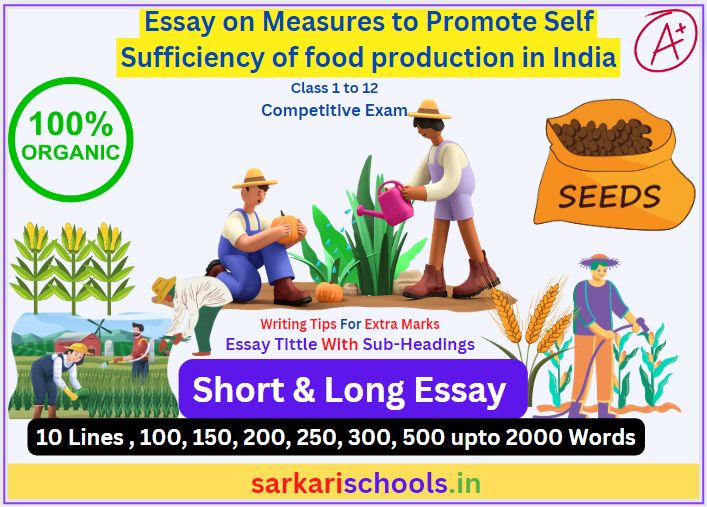Essay on Measures to Promote Self Sufficiency of food production in India Explore essential measures to enhance self-sufficiency in food production in India through diversified agriculture, technological innovation, water management, organic farming, smallholder support, infrastructure development, government policies, and consumer education. Discover how these strategies collectively drive food security and economic stability in India’s diverse agricultural landscape.
Table of Contents

Essay on Measures to Promote Self Sufficiency of food production in India
Introduction
The concept of self-sufficiency in food production is a cornerstone of ensuring a nation’s ability to feed its population from its own agricultural resources, without relying heavily on imports. In an era marked by globalization and interconnected markets, achieving self-sufficiency in food production holds paramount importance for both food security and economic stability. This becomes particularly pertinent in the context of India, a country renowned for its diverse agricultural landscape and vast population. With the need to feed over 1.4 billion people, India’s agricultural strategies must be tailored to its unique agro-climatic regions, acknowledging the distinct challenges and opportunities they present. As we explore the measures to promote self-sufficiency in food production, it becomes evident that a balanced and strategic approach is not only essential but imperative for India’s sustenance and prosperity.
Essay on Measures to Promote Self Sufficiency of food production in India
Diversification of Agricultural Practices
Significance of Identifying Suitable Crops Based on Regional Conditions
One of the primary steps towards promoting self-sufficiency in food production in India is the strategic identification of crops that are best suited to the unique agro-climatic conditions of different regions. India’s vast geographical expanse encompasses a wide range of climates, soil types, and rainfall patterns. Therefore, tailoring crop choices to these specific conditions can significantly enhance productivity and reduce vulnerability to climatic variations.
When crops are selected based on regional suitability, they are more likely to thrive and yield optimal harvests. For instance, arid regions could focus on drought-resistant crops, while areas with ample rainfall might prioritize water-intensive crops. This approach maximizes resource efficiency, reduces input costs, and minimizes the risks associated with crop failures due to adverse weather events.
Benefits of Crop Rotation and Intercropping for Soil Health and Pest Management
Crop rotation and intercropping are sustainable agricultural practices that offer substantial benefits for both soil health and pest management. Crop rotation involves systematically changing the types of crops grown in a particular field over successive seasons. Intercropping, on the other hand, involves cultivating two or more crops simultaneously in the same field. These practices provide a range of advantages:
- Soil Health Improvement: Different crops have varying nutrient requirements and impacts on soil health. By rotating crops, soil nutrient depletion is minimized, as some crops help restore soil fertility by fixing nitrogen and other nutrients. This promotes long-term soil productivity and reduces the need for synthetic fertilizers.
- Pest and Disease Management: Continuous cultivation of the same crop can lead to the buildup of specific pests and diseases. Crop rotation disrupts the life cycles of these pests, reducing their prevalence. Intercropping can also deter pests by creating an unfavorable environment and promoting natural pest predators.
- Weed Control: Intercropping and crop rotation can help suppress weed growth, as different crop combinations shade the soil and limit weed establishment. This reduces the need for herbicides and manual weeding.
- Enhanced Biodiversity: Intercropping and crop rotation diversify the plant species in a field, encouraging beneficial insects, pollinators, and microbial life. This ecological diversity contributes to overall ecosystem health.
- Risk Reduction: If one crop fails due to adverse conditions or pest outbreaks, the other crops in a diversified system may still thrive, reducing the overall risk of complete crop loss.
In conclusion, diversifying agricultural practices through the identification of region-specific crops and the implementation of crop rotation and intercropping techniques can play a pivotal role in promoting self-sufficiency in food production in India. These practices not only enhance productivity but also contribute to environmental sustainability, making them valuable components of a comprehensive strategy to ensure food security and economic stability.
Essay on Measures to Promote Self Sufficiency of food production in India
Investment in Research and Technology
Role of Research Institutions and Agricultural Universities
Research institutions and agricultural universities play a critical role in driving innovation and progress in the agricultural sector. Their contributions extend from fundamental scientific research to the practical application of cutting-edge technologies on the farm. These institutions serve as hubs of knowledge creation, dissemination, and skill development for both farmers and researchers.
By investing in research institutions and agricultural universities, India can harness the power of knowledge to address the evolving challenges in food production. These institutions provide a platform for collaborative research, where scientists can collaborate with farmers to identify region-specific issues and develop contextually relevant solutions. Moreover, they offer training programs that empower farmers with the latest agricultural practices and technologies.
Development of High-Yielding Crop Varieties, Disease-Resistant Plants, and Precision Agriculture
- High-Yielding Crop Varieties: Research institutions play a pivotal role in developing crop varieties that exhibit higher yields while maintaining essential traits like taste, nutritional value, and resilience to environmental stress. These high-yielding varieties are often the result of selective breeding or genetic modification, designed to optimize crop performance under specific conditions.
- Disease-Resistant Plants: Developing plants that are naturally resistant to pests and diseases reduces the reliance on chemical pesticides, promoting environmentally friendly and sustainable agriculture. Research focuses on identifying genes that confer resistance and incorporating them into crop varieties.
- Precision Agriculture: Precision agriculture involves using technology and data to optimize resource allocation on a per-plant or per-field basis. This approach ensures that inputs like water, fertilizers, and pesticides are used efficiently, minimizing waste and environmental impact. Techniques such as satellite imaging, GPS-guided machinery, and sensor technology contribute to precision agriculture’s success.
Research institutions and agricultural universities facilitate the development of these technologies through rigorous scientific exploration, experimentation, and collaboration with farmers. Their role in disseminating knowledge about these advancements is equally crucial, ensuring that farmers can access and implement the latest tools to enhance productivity.
In conclusion, investing in research institutions and agricultural universities is a foundational step towards achieving self-sufficiency in food production. These institutions drive advancements in high-yielding crop varieties, disease-resistant plants, and precision agriculture, all of which collectively contribute to boosting agricultural productivity, sustainability, and the overall economic growth of the country.
Essay on Measures to Promote Self Sufficiency of food production in India
Water Management and Irrigation
Importance of Efficient Water Management in Agriculture
Efficient water management in agriculture is crucial due to the limited availability of water resources and the growing demand for agricultural products. Agriculture is a water-intensive activity, and as water scarcity becomes a pressing issue globally, it is imperative to utilize water resources judiciously. Efficient water management not only ensures sustainable agricultural practices but also addresses environmental concerns and supports long-term food security.
Rainwater Harvesting, Reservoirs, and Modern Irrigation Methods
- Rainwater Harvesting: Rainwater harvesting involves collecting and storing rainwater for agricultural use. This practice is particularly important in regions with seasonal rainfall patterns. Capturing rainwater through techniques such as rooftop collection systems, check dams, and percolation ponds helps recharge groundwater levels, reducing dependency on surface water sources during dry periods.
- Reservoirs: Constructing reservoirs, dams, and water storage facilities helps regulate water supply for agricultural purposes. These structures store excess water during monsoon seasons and release it gradually throughout the year. This approach ensures a steady water supply for irrigation, especially during critical growing stages of crops.
- Modern Irrigation Methods: Traditional flood irrigation methods can be highly wasteful, leading to waterlogging, soil erosion, and uneven distribution of water. Modern irrigation methods such as drip irrigation and sprinkler irrigation deliver water directly to the roots of plants, minimizing water wastage and maximizing efficiency. These methods are particularly advantageous in water-scarce regions.
Utilization of Recycled Water and Treated Wastewater
- Recycled Water: Recycled water, often treated sewage or wastewater, can be repurposed for agricultural use. Properly treated recycled water can provide a consistent and reliable water source for irrigation. This practice reduces the strain on freshwater resources and lessens the environmental impact of wastewater disposal.
- Treated Wastewater: Wastewater from domestic, industrial, and agricultural sources can be treated to remove contaminants and pathogens. Treated wastewater, when properly managed and treated to appropriate standards, can serve as an additional source of water for irrigation. However, stringent treatment processes are essential to ensure the safety of crops and the environment.
Utilizing these water management techniques enhances water availability for agricultural activities, reduces pressure on conventional water sources, and promotes sustainable agricultural practices. These measures are crucial for adapting to changing climate patterns and addressing the water challenges faced by the agricultural sector.
In conclusion, efficient water management and irrigation practices are essential for promoting self-sufficiency in food production in India. By embracing techniques such as rainwater harvesting, reservoir construction, modern irrigation methods, and the utilization of recycled water and treated wastewater, India can optimize water resources, enhance agricultural productivity, and contribute to long-term food security and environmental sustainability.
Essay on Measures to Promote Self Sufficiency of food production in India
Promotion of Organic Farming
Advantages of Organic Farming for Health and Environment
Organic farming is a sustainable agricultural approach that avoids the use of synthetic chemicals and focuses on maintaining the health of ecosystems, soils, and people. It offers several significant advantages for both human well-being and the environment:
1. Health Benefits: Organic farming produces food that is free from synthetic pesticides, herbicides, and genetically modified organisms (GMOs). This results in lower residual pesticide content in crops, reducing consumers’ exposure to potentially harmful chemicals. Organic produce is also often richer in nutrients and antioxidants, contributing to improved nutrition and health outcomes.
2. Soil Health: Organic farming prioritizes soil health by avoiding the use of chemical fertilizers and promoting natural nutrient cycling. Practices like crop rotation, composting, and cover cropping enhance soil structure, fertility, and microbial diversity. Healthy soils are better equipped to retain water, resist erosion, and support robust plant growth.
3. Biodiversity Conservation: Organic farming encourages the presence of diverse plant and animal species on farms. Avoiding synthetic chemicals and cultivating diverse crops create habitats for beneficial insects, birds, and pollinators. This approach helps maintain ecosystem balance and supports natural pest control.
4. Reduced Environmental Impact: The absence of synthetic chemicals in organic farming reduces the risk of soil and water contamination. It also decreases greenhouse gas emissions associated with chemical production and application. Additionally, organic farming practices such as agroforestry and mixed cropping contribute to carbon sequestration, aiding in climate change mitigation.
Government Incentives, Training Programs, and Subsidies for Organic Practices
To encourage the adoption of organic farming, governments provide a range of incentives, training programs, and subsidies:
1. Financial Support: Governments offer financial incentives to farmers who transition to organic practices. These incentives can include grants, low-interest loans, and subsidies for organic certification costs. Financial support eases the initial investment and operational costs associated with organic farming.
2. Training and Education: Agricultural extension services and training programs are conducted to educate farmers about organic farming techniques. Workshops, seminars, and demonstrations familiarize farmers with organic practices, pest management strategies, and sustainable soil management techniques.
3. Certification Support: Obtaining organic certification can be a complex process. Governments often provide assistance to farmers navigating the certification process, making it more accessible and manageable.
4. Market Access: Governments may facilitate market access for organic produce by connecting organic farmers with consumers, retailers, and food processors. Certifications from government-accredited bodies can enhance consumer trust and facilitate market entry.
By combining these measures, governments aim to create an enabling environment for farmers to embrace organic farming practices. This not only benefits farmers economically but also contributes to public health, environmental sustainability, and the long-term resilience of the agricultural sector.
In conclusion, the promotion of organic farming brings a multitude of benefits for human health, ecosystem well-being, and sustainable agriculture. Government incentives, training programs, and subsidies play a vital role in encouraging farmers to adopt organic practices, fostering a transition towards a more environmentally friendly and health-conscious agricultural system.
Essay on Measures to Promote Self Sufficiency of food production in India
Support for Smallholder Farmers
Significance of Smallholder Farmers in India’s Agricultural Landscape
Smallholder farmers are the backbone of India’s agricultural sector, contributing significantly to food production, rural employment, and economic growth. These farmers typically cultivate small plots of land using traditional methods, making them crucial for ensuring food security, reducing poverty, and sustaining rural communities. Given that the majority of India’s population resides in rural areas, the well-being of smallholder farmers directly impacts the overall social and economic fabric of the country.
Need for Farmer Cooperatives, Access to Credit, and Market Facilitation
- Farmer Cooperatives: Smallholder farmers often face challenges such as limited access to resources, market information, and bargaining power. Farmer cooperatives, where farmers pool their resources and collectively market their produce, can enhance their bargaining strength, improve access to inputs, and provide a platform for knowledge sharing. These cooperatives empower farmers to negotiate better prices, access modern technology, and jointly address challenges.
- Access to Credit: Lack of access to affordable credit is a major barrier for smallholder farmers. Governments and financial institutions can offer targeted credit programs tailored to the needs of small farmers. Microfinance schemes, crop loans, and insurance products can provide the necessary financial support for investing in seeds, equipment, and modern agricultural practices.
- Market Facilitation: Smallholder farmers often struggle to connect with formal markets due to information gaps, infrastructure limitations, and transportation issues. Creating efficient market linkages, establishing market information systems, and supporting the development of local marketplaces can enable farmers to sell their produce at better prices and reduce post-harvest losses.
Emphasis on Education and Training for Small Farmers
- Agricultural Education: Providing smallholder farmers with access to agricultural education equips them with the knowledge and skills needed to adopt modern and sustainable farming practices. Training programs can cover topics such as soil health management, water conservation, pest control, and crop diversification.
- Digital Literacy: Familiarity with modern communication tools can help small farmers access weather forecasts, market prices, and best agricultural practices. Digital literacy programs can empower them to make informed decisions and adapt to changing conditions.
- Financial Literacy: Educating smallholder farmers about financial management, credit options, and savings strategies enhances their financial resilience and helps them make informed choices regarding investment and expenditure.
Education and training not only improve the livelihoods of small farmers but also contribute to increasing agricultural productivity, reducing environmental impact, and enhancing overall rural development.
In conclusion, supporting smallholder farmers is crucial for ensuring inclusive and sustainable agricultural growth in India. Establishing farmer cooperatives, providing access to credit and market facilitation, and emphasizing education and training can collectively empower small farmers to overcome challenges, improve their productivity, and contribute significantly to food security and economic prosperity.
Essay on Measures to Promote Self Sufficiency of food production in India
Infrastructure Development
Role of Infrastructure in Reducing Post-Harvest Losses and Wastage
Infrastructure development is a key factor in transforming the agricultural landscape and reducing post-harvest losses and wastage. Post-harvest losses occur at various stages of the supply chain, from harvesting to consumption. Inadequate infrastructure exacerbates these losses, negatively impacting food security, farmer incomes, and overall economic efficiency.
Better Roads:
- Transportation Efficiency: Improved road networks provide efficient transportation routes for agricultural produce from farms to markets. Well-maintained roads reduce travel time, prevent damage to perishable goods, and facilitate the timely delivery of crops to consumers.
- Access to Markets: Remote and rural areas often lack proper road connectivity, isolating farmers from lucrative markets. Good road infrastructure enhances access to wider markets, enabling farmers to reach consumers beyond their immediate vicinity.
Cold Storage Facilities:
- Extended Shelf Life: Cold storage facilities preserve the quality and freshness of perishable products by maintaining optimal temperatures. This extends the shelf life of produce, reducing spoilage and increasing the chances of fetching better prices.
- Market Flexibility: Cold storage enables farmers to store surplus produce during times of bumper harvests and release it gradually during periods of low supply. This helps stabilize market prices and prevents gluts or shortages.
Food Processing Units:
- Value Addition: Food processing units allow farmers to convert raw produce into processed goods, such as packaged fruits, vegetables, and dairy products. This adds value to the products and opens up opportunities for higher profit margins.
- Reduced Wastage: Processing units can convert surplus or imperfect produce into value-added products, reducing the amount of produce that goes to waste due to cosmetic imperfections.
- Diversification of Products: Processing units can encourage farmers to diversify their product range and explore niche markets, reducing dependency on a single crop and spreading risk.
Infrastructure development directly addresses the challenges of inadequate storage and inefficient transportation that contribute to significant post-harvest losses. By investing in better roads, cold storage facilities, and food processing units, countries can minimize wastage, stabilize prices, and ensure a more efficient flow of agricultural products from farm to fork.
In conclusion, infrastructure development in agriculture is not just about physical structures but about enhancing the entire supply chain. Through the provision of better roads for transportation, cold storage facilities for preservation, and food processing units for value addition, a more robust and efficient agricultural ecosystem can be created. This, in turn, contributes to reducing post-harvest losses, increasing farm incomes, and ultimately improving food security and sustainability.
Essay on Measures to Promote Self Sufficiency of food production in India
Government Policy and Support
Importance of Stable and Supportive Government Policies
Stable and supportive government policies play a pivotal role in fostering a conducive environment for agricultural growth and self-sufficiency. Agriculture is highly influenced by external factors such as climate, market fluctuations, and global trade dynamics. Well-designed policies can mitigate risks, incentivize production, and provide a safety net for farmers, contributing to food security and economic stability.
Fair Pricing, Subsidies, and Insurance Schemes for Farmers
- Fair Pricing: Government policies that ensure fair and remunerative prices for agricultural products are essential. Fair pricing protects farmers from price volatility, discourages exploitation by middlemen, and provides a predictable income stream. It encourages farmers to invest in modern techniques, better seeds, and improved practices, ultimately enhancing production.
- Subsidies: Targeted subsidies on inputs such as fertilizers, seeds, and irrigation equipment can alleviate the financial burden on farmers and promote sustainable agricultural practices. Subsidies can enhance affordability, encourage adoption of modern technologies, and lead to increased yields.
- Insurance Schemes: Agricultural production is vulnerable to various risks, including weather-related disasters and pest outbreaks. Government-backed crop insurance schemes provide a safety net for farmers by compensating them in case of crop failure. These schemes reduce the financial uncertainty associated with unpredictable events and encourage farmers to take calculated risks.
Role of Market Interventions to Stabilize Prices
- Price Stabilization: Market prices for agricultural commodities can be highly volatile due to factors like supply-demand imbalances, weather fluctuations, and global market trends. Government interventions, such as procurement at minimum support prices (MSP), can stabilize prices by ensuring a floor price for produce, preventing drastic fluctuations.
- Buffer Stocks: Governments can create buffer stocks of essential commodities to counter supply shortages and surpluses. These stocks can be released into the market during times of scarcity to regulate prices and ensure steady supply.
- Market Information: Providing accurate and timely market information to farmers empowers them to make informed decisions about when, where, and at what price to sell their produce. Information dissemination helps farmers avoid market manipulation and obtain better prices.
Stable government policies that encompass fair pricing, subsidies, insurance schemes, and market interventions create a favorable environment for farmers, ensuring their financial security and incentivizing sustainable agricultural practices. These policies also contribute to food security by promoting increased production and minimizing risks associated with market uncertainties.
In conclusion, government policy and support are integral components of promoting self-sufficiency in food production. By establishing policies that protect farmers’ interests, provide financial security, and stabilize market prices, governments can contribute significantly to enhancing agricultural productivity, ensuring food security, and fostering economic stability.
Essay on Measures to Promote Self Sufficiency of food production in India
Education and Awareness
Raising Awareness for Better Consumer Choices and Reduced Wastage
Raising awareness among consumers about their role in promoting self-sufficiency in food production can have a transformative impact on both consumption patterns and food wastage. Consumer behavior significantly influences the demand for various agricultural products, which in turn affects production decisions. By imparting knowledge about the importance of sustainable consumption and the impact of their choices on the agricultural ecosystem, individuals can make more informed decisions that contribute to reduced wastage and increased self-sufficiency.
Educational Campaigns about the Importance of Domestic Produce
Educational campaigns that emphasize the significance of consuming domestic produce can drive positive changes in consumer preferences and habits. These campaigns can highlight several key points:
- Support for Local Farmers: By choosing domestic produce, consumers directly support local farmers and contribute to their livelihoods. This, in turn, strengthens the agricultural sector and local economies.
- Reduced Carbon Footprint: Locally produced food has a lower carbon footprint compared to imported goods that have traveled long distances. Consuming locally grown food reduces transportation-related emissions and contributes to environmental sustainability.
- Freshness and Nutritional Value: Locally produced food is often fresher and retains more nutritional value compared to products that have been transported over long distances. Educating consumers about the superior quality of local produce can incentivize them to make conscious choices.
- Preservation of Biodiversity: Encouraging the consumption of local and traditional varieties of crops and livestock contributes to the preservation of biodiversity. This is essential for maintaining resilient ecosystems and adapting to changing environmental conditions.
- Food Security: Supporting domestic agriculture through consumer choices enhances a country’s food security by reducing dependence on imported goods. This becomes especially crucial during times of global supply chain disruptions.
Impact on Reduced Wastage
Raising awareness about the connection between consumer choices and reduced wastage is equally important. When consumers understand the efforts and resources that go into food production, they are more likely to value food and minimize wasteful consumption. This can lead to decreased food wastage at both the individual and household levels, resulting in more efficient resource utilization and greater overall self-sufficiency.
In conclusion, education and awareness campaigns play a vital role in shaping consumer behavior and driving positive changes in the agricultural landscape. By educating consumers about the benefits of choosing domestic produce, the importance of supporting local farmers, and the role they play in reducing food wastage, societies can contribute to increased self-sufficiency, improved food security, and more sustainable agricultural practices.
Essay on Measures to Promote Self Sufficiency of food production in India
Conclusion
In the pursuit of achieving self-sufficiency in food production, India must adopt a multi-faceted approach that addresses the diverse challenges faced by its agricultural sector. The measures discussed in this essay underscore the interconnectedness of various strategies aimed at enhancing productivity, sustainability, and resilience.
Diversification of Agricultural Practices: Tailoring crops to regional conditions, promoting crop rotation, and intercropping enhance productivity and soil health.
Investment in Research and Technology: Embracing modern technologies, high-yielding crop varieties, and precision agriculture boosts agricultural efficiency.
Water Management and Irrigation: Efficient water management, including rainwater harvesting and modern irrigation methods, ensures water availability in a changing climate.
Promotion of Organic Farming: Organic farming improves health, soil fertility, and ecosystem sustainability.
Support for Smallholder Farmers: Farmer cooperatives, access to credit, and education empower smallholders to thrive.
Infrastructure Development: Better roads, cold storage facilities, and food processing units reduce post-harvest losses.
Government Policy and Support: Stable policies, fair pricing, subsidies, insurance schemes, and market interventions support farmers.
Education and Awareness: Raising awareness about consumption’s impact reduces wastage and drives sustainable choices.
These measures collectively contribute to a comprehensive strategy to achieve self-sufficiency in food production in India. However, success hinges on the collaboration of various stakeholders: the government, agricultural research institutions, farmers, consumers, and the private sector. By recognizing their respective roles and working together, India can create a resilient and self-reliant agricultural ecosystem.
The goal of food self-sufficiency is not just about producing enough food to meet the population’s needs; it’s about ensuring equitable access to nutrition, reducing dependency on external sources, and enhancing the overall well-being of the nation. As a nation with a rich agricultural heritage and a diverse landscape, India possesses the potential to achieve self-sufficiency. By implementing these measures and fostering cooperation among all stakeholders, India can secure a future of food security, economic stability, and sustainable agricultural growth.
Essay on Measures to Promote Self Sufficiency of food production in India
Extra Tips 4 Extra Marks :
Practice Essay Writing Online
Essay on Measures to Promote Self Sufficiency of food production in India Essay on Measures to Promote Self Sufficiency of food production in India Essay on Measures to Promote Self Sufficiency of food production in India Essay on Measures to Promote Self Sufficiency of food production in India Essay on Measures to Promote Self Sufficiency of food production in India





